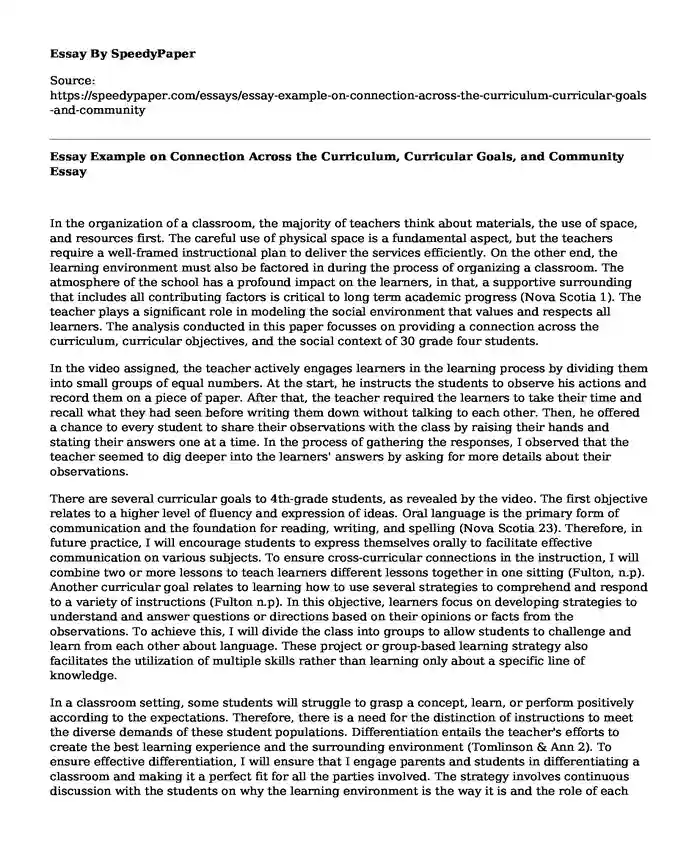
| Type of paper: | Essay |
| Categories: | Teaching Learning Students Classroom management |
| Pages: | 3 |
| Wordcount: | 644 words |
In the organization of a classroom, the majority of teachers think about materials, the use of space, and resources first. The careful use of physical space is a fundamental aspect, but the teachers require a well-framed instructional plan to deliver the services efficiently. On the other end, the learning environment must also be factored in during the process of organizing a classroom. The atmosphere of the school has a profound impact on the learners, in that, a supportive surrounding that includes all contributing factors is critical to long term academic progress (Nova Scotia 1). The teacher plays a significant role in modeling the social environment that values and respects all learners. The analysis conducted in this paper focusses on providing a connection across the curriculum, curricular objectives, and the social context of 30 grade four students.
In the video assigned, the teacher actively engages learners in the learning process by dividing them into small groups of equal numbers. At the start, he instructs the students to observe his actions and record them on a piece of paper. After that, the teacher required the learners to take their time and recall what they had seen before writing them down without talking to each other. Then, he offered a chance to every student to share their observations with the class by raising their hands and stating their answers one at a time. In the process of gathering the responses, I observed that the teacher seemed to dig deeper into the learners' answers by asking for more details about their observations.
There are several curricular goals to 4th-grade students, as revealed by the video. The first objective relates to a higher level of fluency and expression of ideas. Oral language is the primary form of communication and the foundation for reading, writing, and spelling (Nova Scotia 23). Therefore, in future practice, I will encourage students to express themselves orally to facilitate effective communication on various subjects. To ensure cross-curricular connections in the instruction, I will combine two or more lessons to teach learners different lessons together in one sitting (Fulton, n.p). Another curricular goal relates to learning how to use several strategies to comprehend and respond to a variety of instructions (Fulton n.p). In this objective, learners focus on developing strategies to understand and answer questions or directions based on their opinions or facts from the observations. To achieve this, I will divide the class into groups to allow students to challenge and learn from each other about language. These project or group-based learning strategy also facilitates the utilization of multiple skills rather than learning only about a specific line of knowledge.
In a classroom setting, some students will struggle to grasp a concept, learn, or perform positively according to the expectations. Therefore, there is a need for the distinction of instructions to meet the diverse demands of these student populations. Differentiation entails the teacher's efforts to create the best learning experience and the surrounding environment (Tomlinson & Ann 2). To ensure effective differentiation, I will ensure that I engage parents and students in differentiating a classroom and making it a perfect fit for all the parties involved. The strategy involves continuous discussion with the students on why the learning environment is the way it is and the role of each individual in improving it. Also, I will build a support system consisting of other educators with whom I will share the differentiating planning process. The technique is beneficial since the educators can assist in co-teaching and equipping learners with a wide range of knowledge on several subjects.
Works Cited
Fulton, Jenny. “How to Make Cross-Curricular Teaching Part of Your Plan. Classcraft. December 3, 2019.
“Teaching in Action: Grades 4-6.” Nova Scotia, pp. 1-135.
Tomlinson, Carol A. “Differentiation of Instruction in the Elementary Grades.” ERIC
Clearinghouse on Elementary and Early Childhood Education Champaign IL, 2000, pp. 1-7.
Cite this page
Essay Example on Connection Across the Curriculum, Curricular Goals, and Community. (2023, Oct 11). Retrieved from https://speedypaper.com/essays/essay-example-on-connection-across-the-curriculum-curricular-goals-and-community
Request Removal
If you are the original author of this essay and no longer wish to have it published on the SpeedyPaper website, please click below to request its removal:
- Inspiration to Write My Paper. Free Essay Sample.
- Talking About a Student with Parents - Free Essay Example
- Free Essay: The Path to Successful Change at a Manufacturing Company
- Paper Example: Educational Leadership and Transformation
- Essay Sample on The Unlicensed Assistive Personnel
- Essay Sample on A Reflection Essay on Lesson Plan Implementation
- Essay Sample on Impacts of Financial Situation on The Life of University Students
Popular categories




